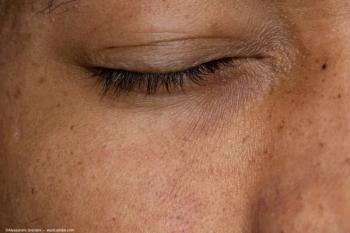
Diffuse-trickling FAF pattern linked to greater ellipsoidal zone loss in GA
Key Takeaways
- Diffuse-trickling FAF patterns are associated with greater EZ loss, indicating potential for rapid GA progression.
- EZ integrity features, measured via spectral-domain optical coherence tomography, serve as biomarkers for GA growth rate.
New research links diffuse-trickling patterns in fundus autofluorescence to increased ellipsoidal zone loss, highlighting potential biomarkers for rapid geographic atrophy progression.
A recent report asserted that the diffuse-trickling pattern on fundus autofluorescence (FAF) is associated with greater amount of ellipsoidal zone (EZ) loss compared to eyes without the diffuse-trickling pattern.
This finding may indicate that EZ loss and early EZ degradation may be important biomarkers for eyes at risk for the rapid growth of
The investigators cited the previous work in this area. One study reported GA growth rates ranging widely from 0.02 to 4.05 mm2/year across eyes.1 Diffuse-trickling patterns and EZ integrity features may help predict the rate of GA lesion growth in patients with dry age-related macular degeneration.2,3 Diffuse-trickling patterns on fundus autofluorescence (FAF) were reported to be associated with rapid progression of GA lesions.2 EZ integrity features measured through spectral-domain optical coherence tomography have been identified as biomarkers of GA growth rate.3-5
The investigators undertook the study under discussion to explore if an association between EZ integrity features and diffuse-trickling FAF patterns can help facilitate a better understanding of the potential interplay between the biomarkers. This study was a post hoc analysis of GATHER1 and GATHER2 data to evaluate the baseline EZ integrity features in eyes with and without diffuse-trickling FAF patterns.
The phase 2/3 GATHER1 (NCT02686658) and phase 3 GATHER2 (NCT04435366) studies evaluated the efficacy and safety of avacincaptad pegol (ACP) 2 mg (Izervay, Astellas Pharma) in patients with Ga that did not involve the central fovea.6,7
The parameters evaluated in the post hoc analysis were the partial EZ attenuation or degradation (defined as the percent of the macular cube with an EZ-retinal pigment epithelial [RPE] thickness of 20 microns or less), total EZ attenuation or loss (defined as the percent of the macular cube with an EZ-RPE thickness of 0 microns), the total EZ-GA gap (defined as the percent of the macular cube with an EZ- RPE thickness of 0 microns minus the percentage of the macular cube with GA), the EZ/GA ratio (defined as the ratio of total EZ attenuation to the GA area percentage), and the EZ-GA index (defined as the total EZ-GA gap divided by the percentage of the macular cube with GA).
Post hoc results
Mean partial EZ attenuation/degradation at baseline was seen in 53.1% of eyes with the diffuse-trickling pattern and in 45.9% without the pattern. This translated to a 16% greater mean baseline partial EZ attenuation associated with eyes with the diffuse-trickling pattern (p = 0.0002).
The mean total EZ attenuation/loss respective values at baseline were 30.7% and 28.5%, a difference that did not reach significance (p = 0.0811).
The mean total EZ-GA gap respective values at baseline were 13.5 % and 10.5%, which was a 29% greater mean value associated with the diffuse-trickling pattern (p = 0.0001).
The mean EZ/GA ratio respective values at baseline were 2.5 and 2.0, which was a 26% greater value in eyes with the diffuse-trickling pattern (p = 0.0324).
The mean EZ-GA indices at baseline were 1.5 and 1.0, translating to a 51% greater EZ-GA index in eyes with the diffuse-trickling pattern (P = 0.0324).
“This pooled post hoc analysis of the GATHER1 and GATHER2 data demonstrated that the diffuse-trickling pattern on FAF was associated with greater EZ loss compared to eyes without the diffuse trickling pattern. This suggests that EZ loss and early EZ degradation may be important biomarkers for eyes at risk for fast GA growth, including those with diffuse trickling. Using these biomarkers may help to provide guidance to clinicians on treatment decision-making to identify eyes at greatest risk for rapid GA progression,” the investigators commented.
References
Colijn JM, Liefers B, Joachim N, et al. Enlargement of geographic atrophy from first diagnosis to end of life. JAMA Ophthalmol. 2021;139:743-750.
Broadbent E, et al. Age-related macular degeneration: natural history revisited in geographic atrophy. Eye (Lond). 2025;39:217-227.
Abraham J, et al. Poster presented at ARVO 2024. Seattle, WA, USA. May 5-9, 2024. Poster 5711-B0117.
Pfau M, von der Emde L, de Sisternes L, et al. Progression of photoreceptor degeneration in geographic atrophy secondary to age-related macular degeneration. JAMA Ophthalmol. 2020;138:1026-1034.
Sarici K, Abraham JR, Sevgi DD, et al. Risk classification for progression to subfoveal geographic atrophy in dry age-related macular degeneration using machine learning-enabled outer retinal feature extraction. Ophthalmic Surg Lasers Imaging Retina. 2022;53:31-39.
Jaffe GJ, Westby K, Csaky KG, et al. C5 inhibitor avacincaptad pegol for geographic atrophy due to age-related macular degeneration: a randomized pivotal phase 2/3 trial. Ophthalmology. 2021;128:576-586.
Khanani AM, Patel SS, Staurenghi G, et al. Efficacy and safety of avacincaptad pegol in patients with geographic atrophy (GATHER2): 12-month results from a randomised, double-masked, phase 3 trial. Lancet. 2023;402(10411):1449-1458.
Newsletter
Don’t miss out—get Ophthalmology Times updates on the latest clinical advancements and expert interviews, straight to your inbox.


















































.png)


